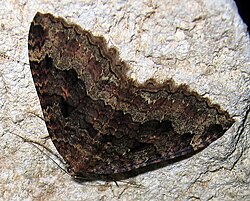| Triphosa dubitata | |
|---|---|
 | |
| Scientific classification | |
| Kingdom: | Animalia |
| Phylum: | Arthropoda |
| Class: | Insecta |
| Order: | Lepidoptera |
| Family: | Geometridae |
| Genus: | Triphosa |
| Species: | T. dubitata |
| Binomial name | |
| Triphosa dubitata | |
| Synonyms | |
| |
Triphosa dubitata, the tissue, is a moth of the family Geometridae. The species was first described by Carl Linnaeus in his 1758 10th edition of Systema Naturae. It is found from north-west Africa across the Palearctic to Japan.
Contents
The wingspan is 38–48 mm. Adults are on wing from August to September depending on the location.

The larvae feed on bird cherry ( Prunus padus ), Rhamnus species (including alder buckthorn ( Rhamnus frangula ), buckthorn ( Rhamnus cathartica ) and ash ( Fraxinus excelsior ).